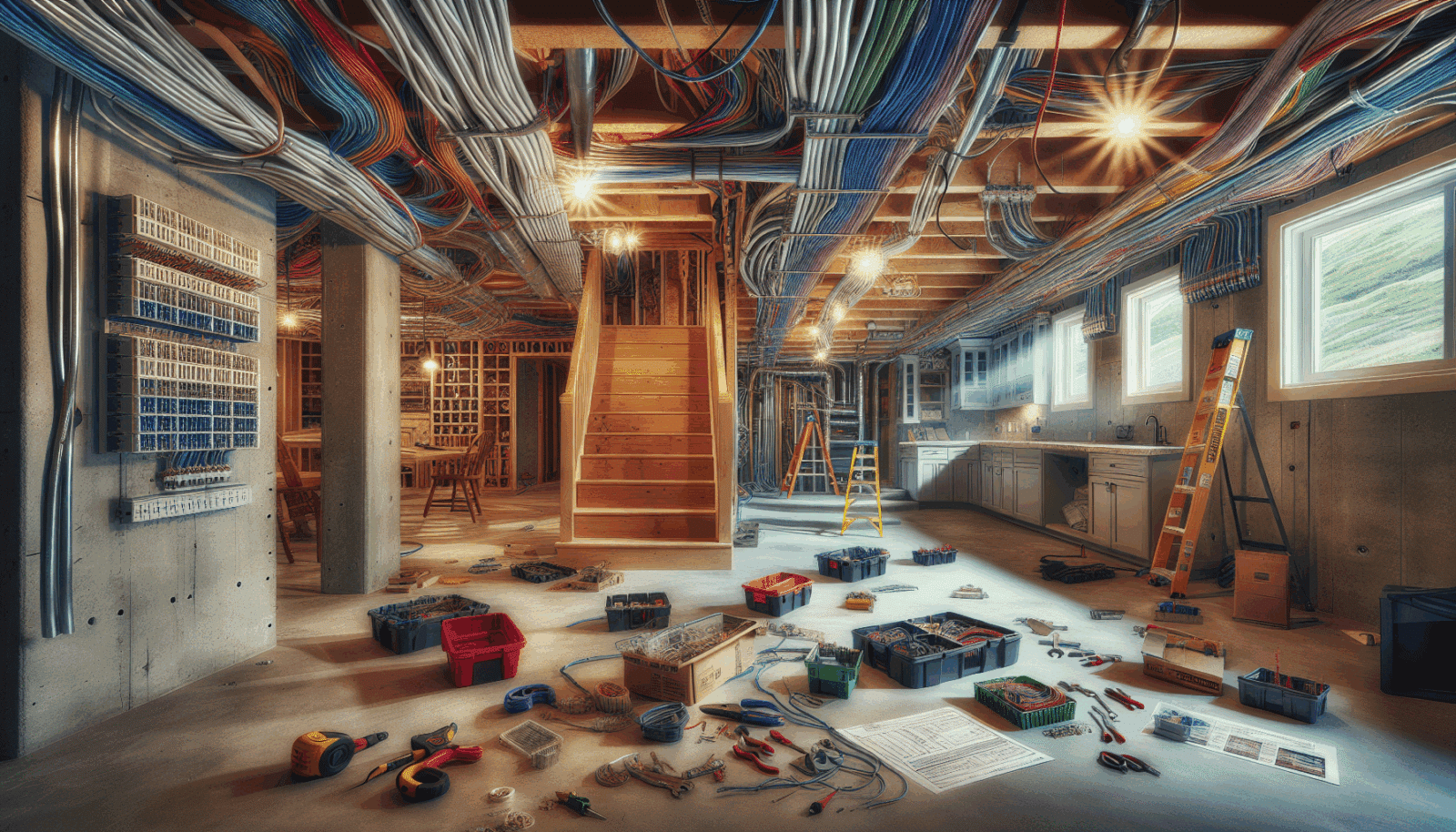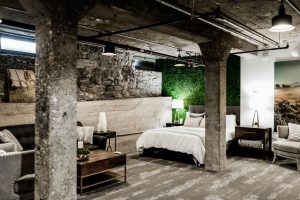Finishing your basement is fun right up until the moment you realize, “Oh… we need to run power everywhere.” Electrical work is the part nobody sees but everybody uses—lights, outlets for TVs and treadmills, heat in winter, sump pump, maybe a kitchenette. And because we’re talking Salt Lake City basements—daylight basements, low ceilings, older ramblers with quirky panels—you can’t just string a few wires and call it good. You need a plan that’s safe, code-compliant, and actually makes the space feel like real living area, not a converted storage room.
Contents
- 1 Why basement electrical isn’t like upstairs
- 2 Start with the layout—where’s the power actually going?
- 3 Safety first—Salt Lake City permits and code stuff (the not-boring version)
- 4 Lighting that actually makes the space feel above-grade
- 5 Outlets, charging, and the real-world stuff
- 6 What about basement apartments and rentals?
- 7 DIY vs. electrician—where to draw the line
- 8 So… how much are we talking?
- 9 Little extras that make a basement feel “done”
- 10 Ready to finish that basement?
Why basement electrical isn’t like upstairs
Here’s the thing: basements have different conditions—concrete, occasional moisture, mechanical rooms, low headroom, sometimes exposed beams. That means the electrical has to be a little tougher and a little smarter. You’ll see more GFCI protection, you may need AFCI on finished areas, and you’ve got to think about how you’ll protect cables that run along foundation walls.
Plus, you’re tying into an existing panel. If your house is a 1960s Sugar House or Millcreek build, that panel might already be full. So before you start dreaming about a home theater, we have to ask: how many new circuits can we add? Do we need a subpanel? Does the service have room?
Start with the layout—where’s the power actually going?
Let me explain. Great basement electrical starts on paper, not after the drywall shows up. Walk the space and mark these zones:
- General living area (family room, gaming, toy area)
- Bedroom(s) for basement apartments or guests
- Bathroom (always power-hungry)
- Kitchenette/wet bar (microwave, fridge, disposal, GFCI)
- Mechanical/storage areas
Each of those zones wants its own circuits or at least its own thinking. Bedrooms and family rooms typically run on 15A or 20A circuits with outlets every 6–12 feet along the walls—yes, even in basements, because the NEC spacing still applies. A bathroom should have a dedicated 20A GFCI-protected circuit. A kitchenette might need two small-appliance circuits if you plan to treat it like a real kitchen.
And don’t forget future you. Maybe you’re not putting a sauna, craft room, or treadmill down there today, but stubbing in an extra circuit or conduit now is cheap. Cutting drywall later is not.
Safety first—Salt Lake City permits and code stuff (the not-boring version)
Honestly, this is where people get tripped up. Salt Lake City, as well as surrounding cities like South Jordan, Sandy, and West Jordan, follow versions of the National Electrical Code with local amendments. That means: yes, you should pull an electrical permit for basement finishing; yes, the work will be inspected; and yes, they will look for GFCI/AFCI where required. That’s not the city being difficult—it’s them protecting your family from shocks and fires.
Here are the safety pieces we watch for:
- GFCI for bathrooms, wet bars, unfinished areas, and anywhere moisture is possible.
- AFCI on finished living areas—bedrooms, family rooms, hallways.
- Smoke/CO detectors tied into the home’s system (basements count as sleeping-level protection).
- Working clearances around the main panel and any subpanel.
We also make sure the basement circuits don’t overload the existing service. If your main panel is already maxed out, we can add a subpanel in the basement—Square D, Eaton, or Siemens panels are common around here—so all the basement circuits have a tidy home.
Lighting that actually makes the space feel above-grade
This is where SLC homeowners get happy. Basements can feel dark, especially on the north side of the house or in winter when we’re all begging for sunlight. Electrical design is how we fake daylight.
Here’s a simple formula that works:
- Recessed LED cans (4″ or 6″) on dimmers for general lighting
- Layered lights—a sconce on a stair wall, an accent over a fireplace, maybe undercabinet lighting for a bar
- Separate zones so the TV side can be dim while the kids’ play area is bright
Use 2700–3000K LEDs if you want warm, living-room vibes. Go 3500–4000K if you’re finishing a home gym, office, or craft space. And since we’re in Utah, where we actually get daylight in the summer, put lights on dimmers—your future electric bill will thank you.
Outlets, charging, and the real-world stuff
You know what? This is the part people always underestimate. Modern basements are not just a couch and a TV. They’re offices, teen hangouts, Airbnbs, or even mother-in-law suites. That means outlets—lots of them.
Here’s what we usually recommend for a finished Salt Lake basement:
- Outlets every 6–12 feet on finished walls (standard spacing)
- Dedicated circuit for a home office or gaming area (yes, even for your PS5)
- GFCI for bar/kitchenette counters
- Receptacle near the TV location for wall-mounts—no cords showing
- One or two floor outlets in big rooms so you don’t have cords running to the walls
We can also install combo USB/Type-C outlets (Leviton and Eaton both make great ones) so you don’t steal all the charger bricks from upstairs. Small upgrade, big “wow.”
What about basement apartments and rentals?
Basement apartments in SLC have a few extra wrinkles—more lighting, more GFCI, separate circuits for kitchen areas, and sometimes even a separate subpanel so the unit can be metered or at least isolated. If you’re planning to rent it (long-term or short-term), doing the electrical right now makes passing inspections and insurance checks way easier later.
Also, don’t forget ventilation fans in basement baths and laundry areas—those need power too, and we like to put them on timers or humidity controls so the space doesn’t get damp.
DIY vs. electrician—where to draw the line
Can you run some low-voltage, staple some cable, or help with layout? Sure. Lots of Utah homeowners are handy. But when we’re talking about tying into the service, adding a subpanel, running new circuits, or pulling a permit, you really want a licensed electrician who works in Salt Lake County all the time. They know what local inspectors like. They know when a conduit is required on a foundation wall. They know when to use a deadfront GFCI versus a device GFCI.
And more importantly—they make it pass on the first inspection so you’re not sitting there with drywall on hold.
So… how much are we talking?
Basement electrical pricing is a little like finishing carpentry—nobody can quote it blind. But here’s a ballpark for Salt Lake City as of right now:
- Basic finished family room (lights + outlets): often $1,500–$3,000
- Basement with bedroom + bath: $3,000–$5,000 depending on fixtures and circuits
- Basement with kitchenette/wet bar: add $800–$1,500 for GFCI, appliance circuits, lighting
- New subpanel for basement circuits: $1,000–$2,000+ depending on distance and service
Those numbers change with material costs, panel capacity, ceiling accessibility, and how finished the space already is. Older homes on the east bench sometimes need more panel work; newer Daybreak or Herriman homes are usually easier because everything’s newer and cleaner.
Little extras that make a basement feel “done”
Since we’re here, let’s talk upgrades:
- Smart switches (Lutron Caséta, TP-Link Kasa) for stair lights or theater lights
- Dedicated circuit for a mini-split if the basement runs cold
- Prewire for network/TV so streaming isn’t laggy through concrete
- Sump pump or radon fan power if your basement has those systems
These are tiny line items now, big conveniences later.
Ready to finish that basement?
If you want a basement that’s bright, safe, and built for the way your family actually lives—not just “technically finished”—getting the electrical designed right is the move. We work all over Salt Lake City and the surrounding cities and we know what the inspectors are looking for. Tell us how you want to use the space—home theater, extra bedroom, rental unit, hangout zone—and we’ll map the circuits, lighting, outlets, and panel upgrades so it actually works.
Reach out and let’s get you a real number.
- By Phone: 801-515-3473
- By Form: https://utbasementfinishing.com/request-quote/#go




